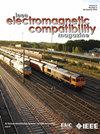Evaluation of Radio Wave Exposure of the Human Head at Multiple Frequencies of Up to 6 GHz
IF 2.5
3区 计算机科学
Q3 ENGINEERING, ELECTRICAL & ELECTRONIC
IEEE Transactions on Electromagnetic Compatibility
Pub Date : 2025-04-21
DOI:10.1109/TEMC.2025.3554689
引用次数: 0
Abstract
Mobile communication devices have become widely used in various situations in our daily lives. Not only are our opportunities for exposure to radio waves increasing, but the exposure environment is also changing owing to developments in telecommunications technology. Conventional studies on radio wave exposure evaluation have focused on only a single frequency, and only a few studies have considered radio wave exposure at multiple frequencies, including the frequencies used in fifth-generation (5G) mobile communications. In this study, specific absorption rate (SAR) evaluations were conducted assuming the exposure of the human body to radio waves with multiple frequency components. To simulate the actual use of a smartphone, analytical models were created using a smartphone model as the electromagnetic wave source and a numerical human body model as the exposure target. In the case of multiple frequencies, SAR was calculated for each frequency component, and SARs were summed. In addition, by changing the power ratio of each frequency component to the total radiated power, the distribution of SAR and the shift in the peak spatial SAR6 GHz以下多频率人体头部无线电波暴露的评估
移动通信设备已经广泛应用于我们日常生活中的各种场合。不仅我们接触无线电波的机会越来越多,而且由于电信技术的发展,接触无线电波的环境也在发生变化。传统的无线电波暴露评估研究只关注单一频率,只有少数研究考虑了多个频率的无线电波暴露,包括第五代(5G)移动通信中使用的频率。在本研究中,假设人体暴露于具有多个频率成分的无线电波,进行了特定吸收率(SAR)评估。为了模拟智能手机的实际使用情况,以智能手机模型为电磁波源,以人体数值模型为暴露目标,建立了解析模型。在多频率情况下,计算每个频率分量的SAR,并对SAR求和。此外,通过改变各频率分量的功率与总辐射功率的比值,研究了SAR的分布和峰值空间SAR$ _{\text{10g}}$ (psSAR$ _{\text{10g}}$)的位移。结果证实了SAR的分布随无线电波中各频率分量的功率比的变化而变化。在具有多个频率分量的无线电波的情况下,没有发现特定的功率比会导致psSAR$ _{\text{10g}}$的显著增加。
本文章由计算机程序翻译,如有差异,请以英文原文为准。
求助全文
约1分钟内获得全文
求助全文
来源期刊
CiteScore
4.80
自引率
19.00%
发文量
235
审稿时长
2.3 months
期刊介绍:
IEEE Transactions on Electromagnetic Compatibility publishes original and significant contributions related to all disciplines of electromagnetic compatibility (EMC) and relevant methods to predict, assess and prevent electromagnetic interference (EMI) and increase device/product immunity. The scope of the publication includes, but is not limited to Electromagnetic Environments; Interference Control; EMC and EMI Modeling; High Power Electromagnetics; EMC Standards, Methods of EMC Measurements; Computational Electromagnetics and Signal and Power Integrity, as applied or directly related to Electromagnetic Compatibility problems; Transmission Lines; Electrostatic Discharge and Lightning Effects; EMC in Wireless and Optical Technologies; EMC in Printed Circuit Board and System Design.

 求助内容:
求助内容: 应助结果提醒方式:
应助结果提醒方式:


